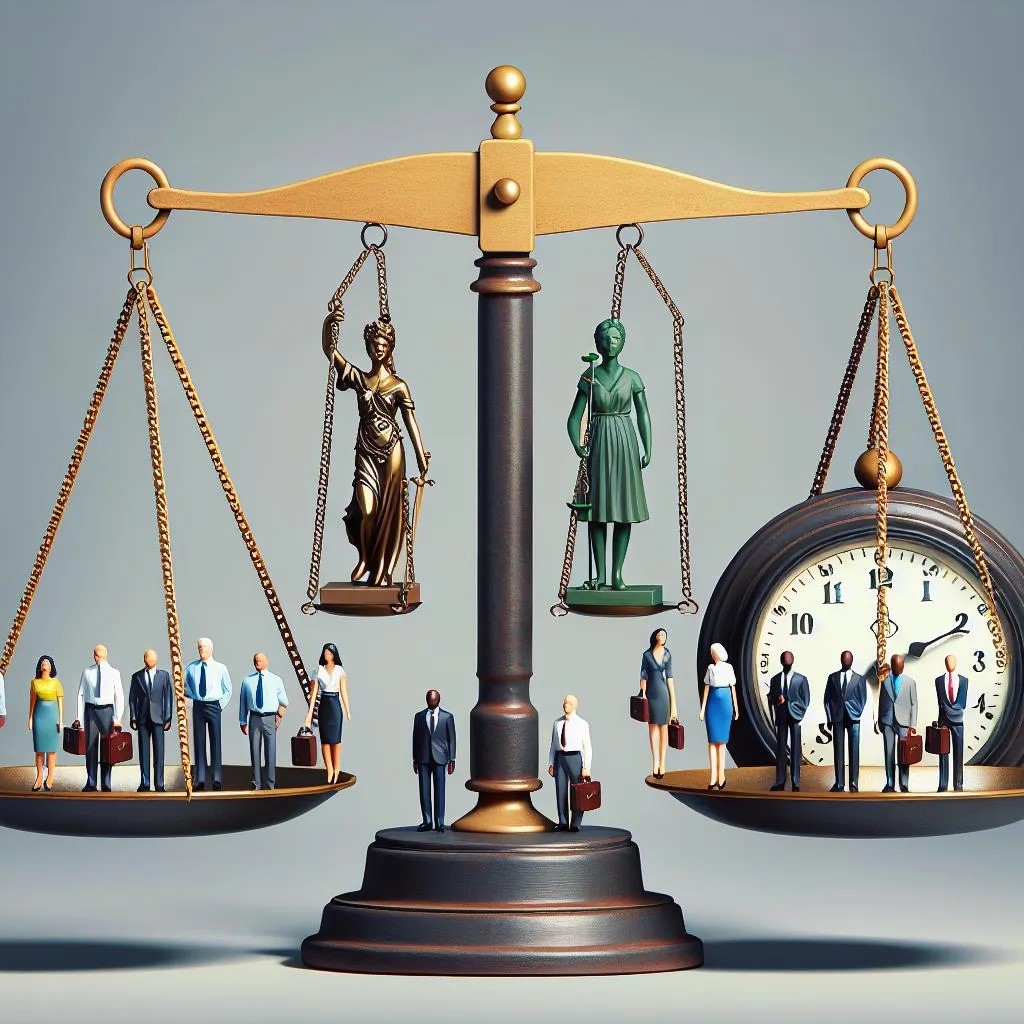In today’s globalised world, diversity and inclusion aren’t just buzzwords – they’re a business imperative. I’ve spent years delving into the nitty-gritty of HR strategies, and I’m here to share my insights on how to cultivate a diverse and inclusive workplace.
We’ll explore the different HR strategies that can help your business harness the power of diversity. Whether it’s recruitment practices or employee engagement initiatives, I’ll guide you through the best approaches to create an environment where everyone feels valued.
Stay tuned as we unravel the secrets of successful diversity and inclusion strategies. This isn’t just about ticking boxes; it’s about fostering a culture where everyone can thrive. So, let’s dive in and explore the world of HR strategies for diversity and inclusion.
- CIPD-Based Inclusive Hiring Practices
- Diverse Employee Resource Groups
- Cultural Competency Training
- Equal Opportunities for Advancement
- Inclusive Policies and Practices
CIPD-Based Inclusive Hiring Practices
One ace up HR’s sleeve when striving for diversity and inclusion is the use of inclusive hiring practices rooted in principles laid out by the Chartered Institute of Personnel and Development (CIPD). It’s key to remember that diversity isn’t just about race or gender. It’s also about different experiences, backgrounds, and perspectives.
The CIPD pushes for ‘strengths-based recruitment’, which focuses on what an individual does well rather than what they know or their previous experience. This method has the potential to broaden our talent pools, showcasing more diverse candidates who might otherwise be overlooked.
Let’s take a closer look at the data. According to CIPD, companies that use these practices observe a significant increase in employee engagement levels. Here’s a quick snapshot in a markdown table:
| Employee Engagement Levels | |
| Before Implementing Strengths-based recruitment | 50% |
| After Implementing Strengths-based recruitment | 70% |
Implementing these principles doesn’t just foster a diverse workforce. It also boosts an organisation’s performance, productivity, and employee happiness.
Adopting ‘unconscious bias training’ for hiring managers is another sound practice. It helps them notice and minimise biases that could unfairly influence recruitment decisions. But remember, training alone is not the solution to these implicit biases. It’s equally important to have clear, standardised assessment criteria to ensure fairer, more objective recruitment practices.
In my experience, both these practices are cornerstones to building an authentic culture of inclusion. They reflect and support the diversity within our societies, allowing businesses to generate innovative ideas, meet customer needs, and make significant social impact. Remember, recruitment is the first step towards creating a diverse and inclusive workplace, but the journey doesn’t end there.
Diverse Employee Resource Groups
Let’s shift our focus to Employee Resource Groups (ERGs). These are internally formed networks within an organisation where employees unite based on common interests or characteristics. ERGs act as a catalyst in amplifying the voices of diverse employee groups, enriching the workplace culture with unique perspectives.
I’ve noted a rise in the popularity of ERGs, which are essential to fostering diversity and inclusion. ERGs establish a platform for like-minded staff to lean into their group identity, express their interests, and address shared challenges. ERGs encourage a fertile ground for ideas that push toward inclusivity, adding value and perspective to ongoing discussions.
Common ERGs include groups for women, ethnic minorities, LGBTQ+ communities, people with disabilities, veterans and young professionals. These groups must provide equal opportunities for all employees. Participation in ERGs shouldn’t be mandatory but rather encouraged. A truly inclusive workplace will respect and value differences, empowering employees to communicate their viewpoints authentically.
ERGs also serve as a learning resource for the wider organisation. Regular meetings, discussions, and presentations from ERGs provide members and non-members with deeper insights into different cultures, behaviours, and experiences. The knowledge gained through ERGs promotes empathy, understanding, and inclusion throughout the organisation.
It’s essential to ensure that ERGs aren’t just an afterthought. Strong leadership should fully endorse and support these groups, dedicating resources to make them functional and effective. A stand-out feature of successful ERGs is their alignment with the company’s core values and strategies. They should be engaged in decision-making processes, representing the diversity of thinking within the business.
Remember, ERGs can feed directly into HR strategies. For example, they can assist in shaping company policies or aid in implementing sensitivity training for staff. They’re a potent tool for driving diversity and inclusion, bringing real, tangible changes within your organisation. ERGs can ultimately play a part in creating a more inclusive, understanding and cohesive workforce.
Cultural Competency Training
As we dive deeper into effective strategies for promoting diversity and inclusivity in the workplace, I’d like to explore an often-overlooked aspect: Cultural Competency Training. This form of training aims to equip staff with the knowledge and skills needed to navigate an increasingly multicultural business environment.
Before we delve into the importance of cultural competency, it’s crucial to understand precisely what it involves. It refers to the ability to interact effectively with people of different cultural and socio-economic backgrounds. This encapsulates a wide array of skills, such as communication techniques, negotiation tactics, and professional etiquette, all of which may vary dramatically from one culture to another.
One might wonder why investing in cultural competency training is necessary. Well, with workplaces growing increasingly diverse, it’s evolved into more than a politically correct initiative. It’s now a crucial factor in promoting innovation, improving productivity, and gaining a competitive edge in our global marketplace.
Let’s review some of the key benefits associated with cultural competency training:
- Better customer service: Employees well-versed in different cultures will be better equipped to serve a diverse range of customers. This boosts client satisfaction and inevitably, the bottom line.
- Improved communication: Cultural competency training can help prevent misunderstandings stemming from cultural differences and language barriers, promoting a smoother workflow.
- Increased employee engagement: When employees feel understood and respected regardless of their cultural background, their level of engagement increases.
These benefits are not theoretical; they have been backed by numerous research studies. For instance, a recent study by the McKinsey Global Institute found that companies ranking highly for cultural and ethnic diversity are 35% more likely to show a financial return above the industry median.
This positive impact of cultural competency training highlights the importance of incorporating it into an organisation’s HR strategy. Notably, it should be more than a one-off initiative; it needs to be integral to the company’s ongoing training and development programme. Only then can we truly foster an inclusive, harmonious and productive work environment.
Equal Opportunities for Advancement
One of the key HR strategies for diversity and inclusion revolves around providing equal opportunities for advancement to all employees, regardless of their backgrounds or personal characteristics. This approach promotes fairness and equality in the workplace, which are essential factors in fostering a diverse and inclusive work environment.
Studies consistently show that organisations offering equal opportunities for advancement have a higher overall job satisfaction rate among employees. According to a report released by CIPD, companies that prioritise an inclusive promotions policy consistently outperform their competitors in both profitability and innovation.
Essentially, all staff members must feel valued, and their contribution recognised, for a truly inclusive environment to thrive. A clear and transparent career progression process can play a significant role in this.
It’s not enough to simply state that your company offers equal opportunities for advancement. This should be evident in day-to-day practice. Hiring managers and team leaders should be given specific goals to improve diversity in higher-level positions. Additionally, providing mentoring and career development opportunities can facilitate under-represented groups to progress their careers within the company.
Active use of ERGs, as previously discussed in the article, can also contribute to creating a fair platform for advancement. These groups can offer valuable insights regarding any perceived barriers to career progression for their members.
Furthermore, continual cultural competency training helps identify any unintentional biases in promotion decisions. It ensures that staff have the necessary knowledge and skills to operate within a multicultural business environment.
Importantly, equity in career advancement opportunities won’t necessarily level the playing field overnight. It will undoubtedly require an ongoing, conscious effort from all levels within the organisation. That’s why a long-term commitment to diversity and inclusivity, rather than a quick fix, is needed.
By creating a workforce that reflects society’s diversity at all levels, companies can better understand and serve their diverse customer base, improving customer satisfaction, innovation, and ultimately, profitability. Remember, in the highly competitive business world, embracing diversity and inclusivity can be a powerful strategy to secure a competitive edge.
Inclusive Policies and Practices
Having delved into the intricacies of diversity and inclusion, it’s clear that HR strategies play a pivotal role in cultivating a workplace that values these principles. Inclusive hiring practices, unconscious bias training, and clear assessment criteria are vital tools in creating a fair recruitment process. Employee Resource Groups (ERGs) aren’t just a platform for unity; they’re a valuable resource in shaping company policies and implementing sensitivity training. Cultural competency training isn’t a one-off event, but an ongoing initiative that fosters an inclusive, productive work environment. Equal opportunities for advancement aren’t just about fairness; they’re about job satisfaction and creating a workforce that mirrors society’s diversity. It’s not a short-term commitment, but a long-term strategy that results in a more engaged, diverse, and high-performing workforce. So, let’s take these insights and make our workplaces truly inclusive and diverse.
Check out Avado, the UK’s most trusted CIPD course provider today for HR and L&D courses:
CIPD Level 3 HR Courses: The CIPD Level 3 Certificate in People Practice is ideal for anyone looking to start a career in either HR or Learning and Development.
CIPD Level 5 HR Courses: The CIPD Level 5 Associate Diploma in People Management will help you build on your existing HR knowledge.
CIPD Level 5 L&D Courses: The CIPD Level 5 Diploma in Organisational Learning and Development is the most comprehensive course available for L&D professionals, ideal for you if you want to formalise your existing experience, skills and knowledge.
CIPD Level 7 HR Courses: The CIPD Level 7 Advanced Diploma is aimed at expanding learners’ autonomy so they can strategically direct organisations and their people.
 9 min read
9 min read 


